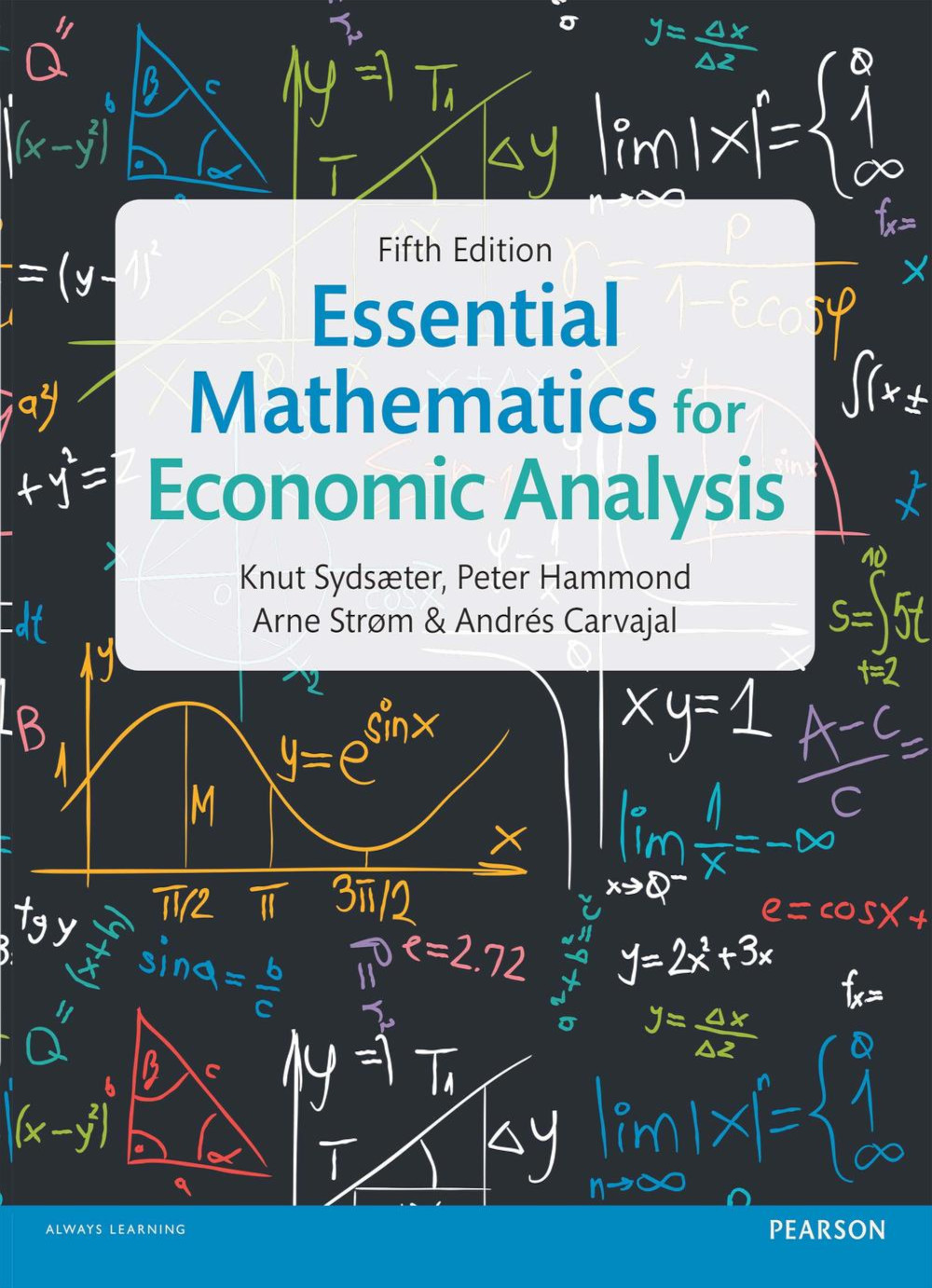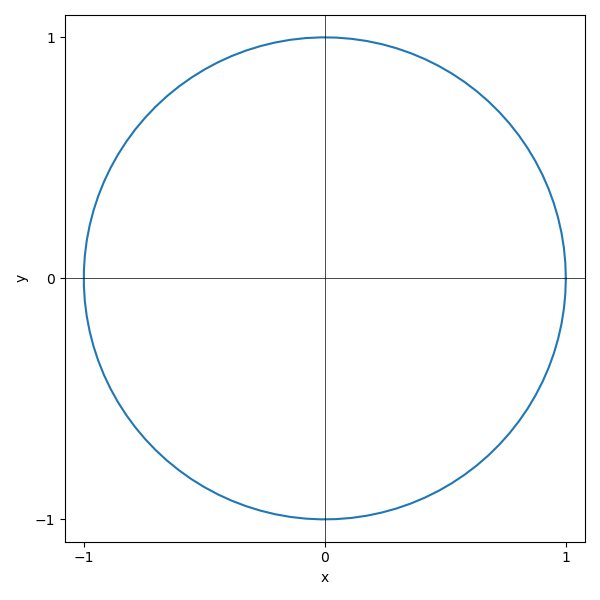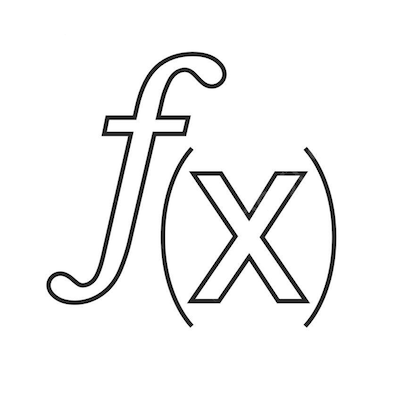Announcements & Reminders
📖 Multivariate differential calculus (part 2)#
⏱ | words
Sources and reading guide

[Sydsæter, Hammond, Strøm, and Carvajal, 2016]
Chapters 11 and 12 (pp. 407-494).
Introductory level references:
[Bradley, 2008]: Chapter 7, Sections 1 to 3 (pp. 360-408).
[Haeussler Jr and Paul, 1987]: Chapter 17, Sections 1 to 7 and Sections 9 to 10 (pp. 668-706 and 714-723).
[Shannon, 1995]: Chapter 10, Sections 1 to 6 (pp. 450-489).
Intermediate mathematical economics textbooks:
[Chiang, 1984]: Chapters 6-8 and Chapter 10 (pp. 127-227 and 268-306).
[Chiang and Wainwright, 2005]: Chapters 6 to 10 (pp. 124-290).
[Simon and Blume, 1994]: Chapters 2 to 5 (pp. 10-103).
Mathematics textbooks:
[Spiegel, 1981]: Chapters 4, 6, 7 and 8; pp. 57-79 and 101-179.
[Spiegel, 1981]: Chapters 3 and 4; pp. 35-81.
Today we will continue our discussion of differential calculus of single-real-valued multivariate functions, \(f: X \subset \mathbb{R}^n \rightarrow Y \subset \mathbb{R}\).
We will be focussing on two concepts. These are implicit functions and homogenous functions.
Implicit functions#
Until now we have been working with explicit functions where the dependet variable, \(y\), is on the left side of the equation and the independet variables, \(x_i\), are on the right side
Frequently, we have to work with equations where the dependent variable cannot be separated from the independent variables
We say that \(G(x_1,x_2,\dots,x_n,y) = c\) represent a relationship between \(y\) and \(x\) that defines an implicit function \(y\) of \(x\).
When dealing with implicit functions we want to know the following two answers:
Does \(G(x_1,x_2,\dots,x_n,y) = c\) determine \(y\) as a continuous implicit function of \((x_1,x_2,\dots,x_n)\)?
If so, how does changes in \(x\) affect \(y\)?
Example: The line of the cicle
The unit cicle has the representation

Consider the point \(x=0\), \(y=1\). In the neighborhood of this point \(y\) is an explicit function of \(x\)
\(y(x)\) can be represented by a different explicit function around the neighborhood at the point \(x=0\), \(y=-1\)
In contrast, \(y\) cannot be represented by a well defined function around the points \((-1,0)\) and \((1,0)\).
Example: Polynomial equation of order five
Consider the polynomial equation
\(x\) can be expressed as an explicit function of \(y\)
However, polynomials of order \(k \geq 5\) has no explicit solution. Hence, there exist no explicit function \(y\) of \(x\). Instead, the polynomial equation defines an implicit function for \(y\) of \(x\).
Suppose we could find a function \(y=y(x)\) which solves this equation for any \(x\)
Use the chain rule to find \(y'(x)\)
The point \(x=-3\), \(y=1\) solves the polynomial equation, and
We conclude that there exists an implicit function \(y=y(x)\) in the neighborhood around (-3,1) that solves polynomial equation and it is differentiable.
Now, let’s carry this computation out more generally for the implicit function \(G(x,y)=c\) around the specific point \(x=x^*\), \(y=y^*\), and let’s suppose there exist a solution \(y=y(x)\). Use the chain rule to differentiate wrt \(x\)
Solving for \(y'(x)\) yields
We see that if the solution \(y(x)\) of \(G(x,y)=c\) exists and is differentiable it is necessary that \(\partial G\left(x_0, y(x_0)\right) /\partial y\) be nonezero. The implicit function theorem stated below implies that this necessary condition is also a sufficient condition.
Fact (Implicit function theorem I)
Let \(G\left(x, y\right)\) be a \(C^1\) function around the point \((x^*,y^*)\) in \(\mathbb{R}^2\). Suppose \(G(x^*,y^*)=c\) and consider the expression
If \(\partial G\left(x^*, y(x^*)\right) / \partial y \neq 0\), then there exists a \(C^1\) function \(y=y(x)\) defined in neighborhood around the point \(x^*\) such that
\(G(x,y(x)) = c\) for all \(x\) around \((x^*,y^*)\)
\(y(x^*)=y^*\)
the derivative of \(y\) wrt \(x\) at \((x^*,y^*)\) is
The implicit function theorem provides conditions under which a relationship of the form \(G(x,y)=c\) implies that there exists a implicit function \(y=y(x)\) locally.
Example: The line of the cicle
When the implicit function theorem is applied to the line of the circle we get that
which is not defined in the point (-1,0) and (1,0) .
The implicit function theoriem can be extended to \(G(x_1,x_2,\dots,x_n)=c\).
Fact (Implicit function theorem II)
Let \(\mathbf{x}=(x_1,x_2,\dots,x_n)\) and \(G\left(\mathbf{x}, y\right)\) be a \(C^1\) function around the point \((\mathbf{x}^*,y^*)\) in \(\mathbb{R}^{n+1}\). Suppose \(G(\mathbf{x}^*,y^*)=c\) and consider the expression
If \(\partial G\left(\mathbf{x}^*, y(\mathbf{x}^*)\right) / \partial y \neq 0\), then there exists a \(C^1\) function \(y=y(\mathbf{x})\) defined in the neighborhood around the point \(\mathbf{x}^*\) such that
\(G(\mathbf{x},y(\mathbf{x})) = c\) for all \(\mathbf{x}\) around \((\mathbf{x}^*,y^*)\)
\(y(\mathbf{x}^*)=y^*\)
for each \(i\) the derivative of \(y\) wrt \(x_i\) is
Example: \(G(x,y,z)=c\)
Consider the relationship
We will show that near \((-1,1,2)\) we can write \(y=y(x,z)\) and we will find the partial \(\partial y / \partial x\) to that point
Find the partial derivatives of \(G\) with respect to \(y\) and \(x\)
The partial derivative is given by the implicit function theorem as
We conclude that there exists a \(C^1\) function \(y=y(x,z)\) in the neighborhood around the point (-1,1,2).
Level sets#
Level curves can be used to visualize single-real-valued bivariate functions, \(f: X \subset \mathbb{R}^2 \rightarrow Y \subset \mathbb{R}\).
Fact (Level curve)
A curve \(\ell\) in \(\mathbb{R}^2\) is called a level curve of \(y=f(x_1,x_2)\) if the value of \(f\) on every point of \(\ell\) is some fixed \(c\).
Example: Level curve
\(x^2 + y^2 = c\) is the level curve of \(z=x^2 + y^2\).
Similarly, level surfaces can be used to visualize single-real-valued trivariate functions, \(f: X \subset \mathbb{R}^3 \rightarrow Y \subset \mathbb{R}\).
Fact (Level surface)
A surface \(S\) in \(\mathbb{R}^3\) is called a level surface of \(f(x_1,x_2,x_3)\) if the value of \(f\) on every point of \(S\) is some fixed \(c\).
Example: Level surface
\(x^2 + y^2 - z = c\) is the level surface of \(w=x^2 + y^2 - z\).
This can of course be generalized to higher order functions, \(f: X \subset \mathbb{R}^n \rightarrow Y \subset \mathbb{R}\)
Fact (Level sets)
A manifold \(M\) in \(\mathbb{R}^n\) is called a level set of \(f(x_1,x_2,\dots,x_n)\) if the value of \(f\) on every point of \(M\) is some fixed \(c\).
The slope of an isoquant curve#
Suppose that \(f: \mathbb{R}_{+}^{2} \rightarrow \mathbb{R}_{+}\) is a production function.
The level curve of the production function represent a relationship between the capital (K) and labor (L) inputs that keeps the production constant at \(c\)
Given the specified production function we might be able to find an explicit or implicit function for the isoquant curve, \(L=L(K)\). In both cases we can use the implicit function theorem to calculate the slope of the isoquant curve.
The slope of the isoquant curve is referred to as the marginal rate of technical substitution
It measures how much of one input would be needed to compensate for a one-unit loss of the other while keeping the production at the same level.
Marginal rate of technical substitution between input \(x_i\) and \(x_j\) of a multivariate function is defined as
Example: \(f(K,L,T)=c\)
Consider the level surface of the Cobb-Douglas function of three inputs (capital, labor, and land)
Calculate the marginal rate of substitution between capital and labor
Calculate the marginal rate of substitution between capital and land
Calculate the marginal rate of substitution between labor and land
Homogeneous functions#
Consider a function \(f: S \longrightarrow \mathbb{R}\), where \(S \subseteq \mathbb{R}^{n}\). Let \(\lambda>0\) be a positive real number.
Definition
The function \(f\left(x_{1}, x_{2}, \cdots, x_{n}\right)\) is said to be homogeneous of degree \(r\) if
for all \(\left(x_{1}, x_{2}, \cdots, x_{n}\right) \in S\) and all \(\lambda>0\).
Example
The function
is homogenous of degree 6
The function
is not homogenous
Definition
A function that is homogeneous of degree one is said to be linearly homogeneous.
Definition
Let \(z=f(x)\) be a \(C^1\) function. If \(f\) is homogenous of degree \(r\), its first order partial derivatives are homogenous of degree \(r-1\).
By definition
Use the chain rule wrt x_i on both sides of the equation
and divide both sides by \(\lambda\)
Fact
Let \(q=f(x)\) be a \(C^1\) homogenous function on \(\mathbb{R}^n_+\). The tangent planes to the level sets of \(f\) have constant slope along each ray from the origin.
Consider the homogenous production function on \(\mathbb{R}^2_+\). We want to show that the MRTS is constant along rays from the origin. Let \((\lambda L_0,\lambda K_0)=(L_1, K_1)\). The MRTS between input \(L\) and \(K\) at \((L_1, K_1)\) equals
Euler’s theorem#
Fact (Euler’s theorem)
Suppose that the function \(f\left(x_{1}, x_{2}, \cdots, x_{n}\right)\) is homogeneous of degree \(r\). In this case we have
Recall the definition of a homogenous function of degree \(r\)
Differentiate both sides wrt \(\lambda\)
Set \(\lambda=1\).
Returns to scale#
Suppose that an \(n\) input and one output production technology can be represented by a homogenous production function of the form
The production technology is said to display:
constant returns to scale: \(f\left(\lambda L_{1}, \lambda L_{2}, \cdots, \lambda L_{n}\right)=\lambda Q\).
decreasing returns to scale: \(f\left(\lambda L_{1}, \lambda L_{2}, \cdots, \lambda L_{n}\right)<\lambda Q\).
increasing returns to scale: \(f\left(\lambda L_{1}, \lambda L_{2}, \cdots, \lambda L_{n}\right)>\lambda Q\).
Cobb-Douglas production functions#
Suppose that an two input and one output production technology can be represented by a production function of the form
This type of production function is known as a Cobb-Douglas production function.
Suppose that \(\lambda>0\). Note that
Thus we know that the Cobb-Douglas production function is homogeneous of degree \((\alpha+\beta)\).
If \((\alpha+\beta)<1\), then the Cobb-Douglas production function displays decreasing returns to scale;
If \((\alpha+\beta)=1\), then the Cobb-Douglas production function displays constant returns to scale; and
If \((\alpha+\beta)>1\), then the Cobb-Douglas production function displays increasing returns to scale.
Homothetict function#
Definition
Let \(I\) be an interval on the real line. Then, \(g: I \rightarrow \mathbb{R}\) is a monotonic transformation on \(I\) if \(g\) is a strictly increasing function on \(I\).
Definition
A function \(v: \mathbb{R}_{+}^n \rightarrow \mathbb{R}\) is called homothetic if it is a monotone transformation, \(g(z)\), of a homogenous function \(u: \mathbb{R}_{+}^n \rightarrow \mathbb{R}\)
for all \(\mathbf{x}\) in the domain.
Example: \(G(x,y,z)=c\)
The two functions
are homothetic functions with \(u(x,y)=xy\) and the monotonic transformations
respectively.
Definition
Let \(u: \mathbb{R}_{+}^n \rightarrow \mathbb{R}\) be a strictly monotonic function. Then, \(u\) is a homothetic if and only if for all \(\mathbf{x}\) and \(\mathbf{y}\) in \(\mathbb{R}^n_+\),
Definition
Let \(u\) be a \(C^1\) function on \(\mathbb{R}^n_+\). If \(u\) is homothetic then the slopes of the tangent planes of the level sets of \(u\) are constant along each ray from the origin.
